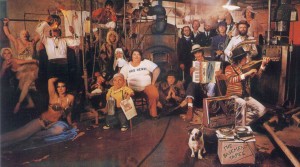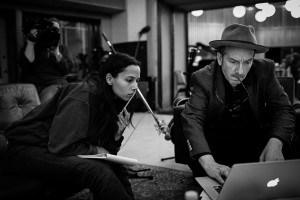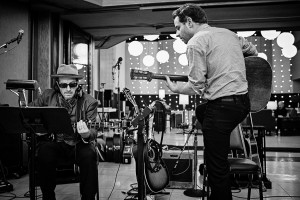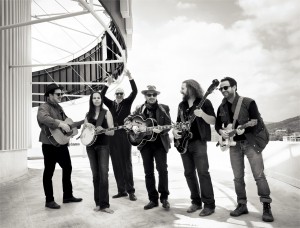In 1965 Bob Dylan went electric at Newport and everyone fucking hated it. Ok, not everyone—there were boos and cheers, after all. Later that year he got married, got strung out on heroin, and the following summer almost killed himself in a motorcycle accident. He didn’t emerge from the woods of New York for over a year, only releasing Nashville Skyline and playing at a memorial concert after Woody Guthrie’s death. Dylan wouldn’t tour for another eight years.
Then we got The Basement Tapes.

Post Judeo-Christian lyrics and Johnny Cash duets, Columbia Records releases The Basement Tapes in 1975, approximately eight years after Bob Dylan and the Band (then the Hawks) recorded them in the basement of his Woodstock refuge.
Not unlike when he went electric, Dylan changed the game, singing 107 stripped down, low fidelity ballads that sounded like a whisper under psychedelic rock’s recent explosion. It’s not even so much the songs themselves as what they created— a reemergence of Americana, room for bleakness during the summer of love, not to mention the sheer quantity of the recordings (which has a Jack Kerouac single-spaced, taped together On the Road manuscript type magnitude). Rolling Stone ranked The Basement Tapes #292 on their list of 500 greatest albums and it’s widely regarded that, while lauded on their own merits, The Basement Tapes is what put the Band on the map.
So taking all this in—the circumstances for Dylan, the vastness of recordings, the return to folk for a guy who killed himself going electric, and the legacy it left for singer/songwriters forever (think Wilco, the Waterboys, Billy Bragg)— and now imagine that there are more. That’s right. Unrecorded, half-written, scribbled Dylan songs unknown to the world until 2014.
If you’re a music guy, like T Bone Burnett, this is like finding the library of Alexandria didn’t burn after all. And if you’re smart, like T Bone Burnett, you figure out how to do something with these pieces of lyrical gold.
And that’s how we got The New Basement Tapes.

Week of August 4
Recording of The New Basement Tapes started when songwriter and producer T Bone Burnett got Elvis Costello, Rhiannon Giddens, Jim James, Taylor Goldsmith, and Marcus Mumford all in a studio at Capitol Records, 47 years after Dylan penned the songs they would record. The only catch was, there was no music. Handwritten lyrics in Dylan’s careless scrawl, sure, but no melody, no notes, no instruments, not even “guitar solo here?” scribbled in the margins. The group, then, was undertaking the not so trite task of putting music to the lyrics of one of the greatest songwriters of all time.
So they did.
Over two weeks the group wrote, recorded, experimented, rerecorded, called in Johnny Depp, and rererecorded over 30 songs, 20 of which made the album. With no lineup and a plethora of talent, the group switched parts and instruments, Mumford singing lead on one of the most popular songs, Kansas City, Goldsmith leading the charge on rewriting the music for it, and Giddens bringing in gospel singers to help her find the right melody for Lost on the River.
In Showtime’s documentary of the recording sessions, Lost Songs: The Basement Tapes Continued, Jim James of My Morning Jacket brings his distinctive voice and penchant for the funk and blues inspired, Goldsmith lobbies for his version of Kansas City, (the version that ends up on the album) over Mumford’s, and Burnett refuses to let anyone leave—refuses to let any interpretation go unheard. Burnett describes those two weeks, saying: “What transpired during those two weeks was amazing for all of us. There was a deep well of generosity and support in the studio at all times, which reflected the tremendous trust and generosity shown by Bob in sharing these lyrics with us in the first place.” What’s left is a bold, musically adventurous, deeply curious, and exceedingly fun album of 20 songs that can almost make you forget who wrote them in the first place.

Week of September 1
What’s often lost behind names like Elvis Costello and Marcus Mumford is the fact that The New Basement Tapes is, ultimately, a fan album. I’ll concede that it’s hard to think of professional musicians as fans, no matter how languidly they praise other bands or distill their musical pedigree—but this aspect of them is not to be lost. Before Goldsmith was twelve, I can bet he was learning Bob Dylan songs on the guitar. When Jim James goes to a Wilco concert, it’s not as Jeff Tweedy’s compatriot but as a member of an audience. It takes a concerted effort to remember musicians in their humanity—that is, their capacity to still be a fan. To not make this effort would ignore the foundation of the album as a creative effort of fans, albeit very talented fans, to do justice to the work of another artist. Exempting the Costello and Giddens and Mumford from their role as fans would be a disservice to both them and Dylan. Because, when we’re talking about Bob Dylan, sorta like Jesus, no one’s an equal and everyone’s a fan—fans with professional careers of their own, studio time, and the pull to call in Johnny Depp to play guitar on a track—but fans, nonetheless.
Less stigmatized and perhaps more fruitful, The New Basement Tapes is not altogether unlike popular fanfiction or fan art that is a product of fandoms ranging from books like Twilight to TV shows like Fox’s Glee, except, of course, The New Basement Tapes gets advantage of having Dylan’s actual lyrics. Cover songs in general, while sometimes simply mimicking artists, are more often creative and resourceful interpretations that stand on their own merit—making them works of a fan and works of art. The two are not mutually exclusive. Kurt Mosser gives the example of Jimi Hendrix’s cover of Dylan’s All Along The Watchtower in his essay “Cover Songs”: Ambiguity, Multivalence, Polysemy, saying: “Hendrix… takes an austere and minimalist recording of lyrics that are, even for Dylan, obscure and polysemous and changes it into a driving rock n’ roll song featuring extended displays of Hendrix’s guitar work.” Later, Mosser invokes a philosophy of linguistics, often referenced as “cluster theory”, to show that the very use of the words “cover songs” “indicates that there is a relationship between the cover song and its base,” through referential communication. It is not only the art itself, but the way we—consumers— approach and understand this art that recognizes an inherent connection to an original work of art, while still seeing the newly created, or “cover”, as merited in its own existence. Cover songs, like fan art and fanfiction, just more direct, link the artist with the consumer in a way that makes the consumer an artist, too—if only because they consumed in the first place. Far from the only example, Hendrix’s cover is still perhaps the best at getting at the heart of cover songs as both inextricably linked (and indebted to) the work of the original artist, while still being an independent work of art.
Now take All Along The Watchtower, take away any preexisting musical version, increase the required innovation, and multiply it by 20. That’s The New Basement Tapes.

Week of August 18
On their own, The New Basement Tapes are a remarkable feat of musical ingenuity and collaboration. But it’s status as a quasi fan/cover album resurrects a bias for original work and the dismissal for any art that’s directly based off another’s. Less critiqued because of the commonality of Dylan covers, the genre of fan art and cover art is largely swept under the category of art* where the asterisk says “but not really”. In his essay Like a Version: Cover Songs and the Tribute Trend in Popular Music, George Plasketes gives a number of examples of cover and tribute albums before sweepingly asserting that “the recent proliferation of cover and tribute recordings is culturally characteristic of the repetition mode of postmodern times—retrieving , repeating, rewinding, and resurrecting virtually everything into an exhaustive cycle of retreads.” Ok, is that enough to make Mumford say “ouch”? Plasketes and the like-minded music reviewers he cites devolve cover music into the art of the lazy and unoriginal—those not good enough to write for themselves, or too complacent to do so. Broadened to all fan and cover art and suddenly entire genres and works of art are discounted on the basis of their relationship to the art that came before it. If we can already conclude that consumers are interactive and creative in their relationship with art, as is proved with the very existence of professional cover-bands like the Grateful Dead’s “Dark Star Orchestra” and the plethora of fanfiction posted on sites like tumblr and reddit, then Plasketes argument is that sure, fans make things, but it’s not creative and it’s sure as hell not good. Once mindless consumers are, in this argument, regarded as merely third grade artists redrawing exactly what’s in front of them.
But this argument is too easy. Not only is it reductive of entire swaths of fan-made art, it rests on its laurels in equating “unoriginal” and “repetitive” with bad, despite giving no critique of the genre other than its straightforward description: art made in the image (or sound) of other art.
The New Basement Tapes are perhaps the highest functioning form of this art and avoid criticism like Pasketes by its virtue of being so well done—it is, however, very much the paradigm of what Plaskete criticizes. More than anything, it’s important to see that The New Basement Tapes is very much the rule for fan and cover art, and not the exception—not in terms of quality (not everyone can sing, not everyone has access to Capitol Records, this is a given) but in the creativity and ingenuity it inspires in the consumer. That art is able to, at the very least, inspire its consumers to create their own work, regardless of quality, is a testament to the critical engagement of the consumer. The New Basement Tapes wouldn’t exist without Bob Dylan or his lyrics, and in this way it’s exactly like 50 Shades of Grey and Twilight, Kirk/Spock slash fiction and Startrek. Each “cover” owes something to its “original”— but complacent, simple-minded replications of their respective originals they are not. Regardless of the social stigma attached or lacking to each of these forms of fan/cover art, and with little emphasis put on their varying qualities (i.e. good/bad), they all arise from the same circumstances of a consumer interacting with its culture, a fan reading and listening critically, and then deciding that they, too, can create something.
So they do.

Burnett and the group he assembled manage to record one of the most musically complex and wide ranging albums of the 2000s. Whether or not you like the album (Rolling Stone loves it, Pitchfork is ambivalent), The New Basement Tapes occupies a space as one of the most creative and experimental cover albums of Dylan’s work. Rather than a carbon copy of Dylan’s simplicity and growling voice, The New Basement Tapes incorporates instruments unknown to Dylan’s work and lets the music breathe. In Matt Melis’ review of the album, which appears on the music-news website consequenceofsound.net, he concludes the article by surmising that the listener “[gets] the sense that Dylan’s greatest gift to the band may not have been his lyrics. The real gift may have been giving Burnett and these five musicians an excuse to go and chase down their own Basement Tapes.” To generalize this claim is to get at the very heart of fan/cover art, or any art directly influenced by a single force, which is that while the content of the original art is imperative, it’s the opportunity for creativity, collaboration, and ingenuity that it creates, and which the consumer seizes, that makes it so important.
We may call Bob Dylan a musical god but we certainly don’t treat him like it. Music, in this way, is not prescriptive. Jim James doesn’t listen to Dylan like the prophet Muhammed and worship at his feet but rather brings goddamn psychedelic Kentucky blues-rock to songs written while Dylan was reading way too much Bible and stripping down his recordings. Giddens, a black woman from the band Carolina Chocolate Drops, brings a soul that white people have been trying to replicate since Alan Lomax went recording local folk songs all over the American south. Taylor Goldsmith comes in as the young, unknown guy from a mid-level band that’s best known for its first album, and fights to the death with Marcus Mumford (of slightly more fame…) to get his (better) version of a song recorded. The New Basement Tapes is not a tribute album, it’s not an homage to Dylan—by the time it’s recorded, it’s not even a Dylan Manifesto. The New Basement Tapes is full fledged musical ingenuity that springs from the handwritten lyrics of a guy they all admire; a guy they’ve all called a genius, once or twice.
Where Dylan would have liltingly sung, Costello belts. Where Dylan would go acoustic, James shreds and Giddens wails. Where Dylan might mope, Marcus goes passionately rueful, as if to say “I’m not finished yet.” These songs, while a gift from Dylan, exist in their own merit. They take liberties with Dylan’s lyrics, are made of a style all their own, and are the product of a critical, creative process of engaging with a music legend’s work. To ignore the impact of Bob Dylan in creating this record would be empirically wrong– he is undeniably the source of inspiration and the well from which these songs were recorded. But to dismiss The New Basement Tapes as a recreation or a carbon copy with no merit or originality of its own would be deaf to the music on the album. More than anything, The New Basement Tapes embodies the relationship between consumer and artist; fan and artist; artist and artist. In it, the very real link between consuming and creating becomes tangible, resulting in a creative product of its own merit, made possible only by the existence of fan and artist and the active, engaging relationship between the two.